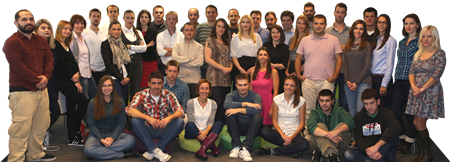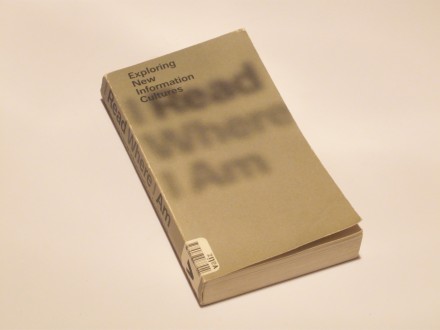I Read Where I Am: Exploring New Information Cultures
| Cena: |
2.000 din
(Predmet je prodat)
|
| Stanje: | Polovan bez oštećenja |
| Garancija: | Ne |
| Isporuka: | Pošta Post Express Lično preuzimanje |
| Plaćanje: | Tekući račun (pre slanja) Lično |
| Grad: |
Beograd-Zvezdara, Beograd-Zvezdara |
Godina izdanja: 2011
ISBN: 9078088559
Jezik: Engleski
Oblast: Istorija umetnosti
Autor: Strani
- I Read Where I Am: Exploring New Information Cultures
Valiz/Graphic Design Museum, Breda, 2011
264 str.
meki povez
stanje: dobro
– Visionary texts about the future of reading and the status of the word
– With contributions by 82 invited authors: journalists, designers, researchers, politicians, philosophers and many others
I Read Where I Am contains visionary texts about the future of reading and the status of the word. We read anytime and anywhere. We read of screens, we read out on the streets, we read in the office but less and less we read a book at home on the couch. We are, or are becoming, a different type of reader. How will we grapple with compressed narratives and the fluid bombardment of text? What are the dialectics between image and word? How will our information machines generate new reading cultures? Can reading become a live, mobile social experience? To answer all these (and other) questions, I Read Where I Am displays 82 diverse observations, inspirations and critical notes by journalists, designers, researchers, politicians, philosophers and many others.
Authors: Arie Altena, Henk Blanken, Andrew Blauvelt, Erwin Blom, James Bridle, Max Bruinsma, Anne Burdick, Vito Campanelli, Catalogtree, Florian Cramer, Sean Dockray, Paulien Dresscher, Dunny & Raby, Sven Ehmann, Martin Ferro-Thomsen, Jeff Gomez & 66 other authors
Editors: Mieke Gerritzen, Geert Lovink, Minke Kampman
Design: LUST
When Guy Debord identified the image consumerism of “the society of the spectacle” in the 1960s, he could not have forecast that language would threaten to eclipse the image in the medium of personal technology, creating a world of ubiquitous legibility. Today, we read anytime and anywhere, on screens of all sizes; we read not only newspaper articles, but also databases, online archives, search engine results and navigational structures. We read while out on the street, at home or in the office, with a complete library to hand--but less and less we read a book at home on the couch. In other words, we are, or are becoming, a different kind of reader. I Read Where I Am contains visionary texts about the future of reading and the status of the word in the digital age from designers, philosophers, journalists and politicians, looking at both sides of the argument for printed and digital reading matter.
A collection of short reflections on the future of reading, including those from Ellen Lupton, James Bridle, Erik Spiekermann, and N. Katharine Hayles. Independently, none of the essays are especially compelling; but collectively, they reveal our shared unease (the loss of print, increased distraction, information overload) and make clear that none of us has any idea what the future will bring. Which, of course, is what makes the future interesting. Unfortunately, the typesetting (words are colored in different shades of gray depending on their frequency of use) is interesting in theory but incredibly annoying in practice; perhaps it is an attempt to prove that a stubborn reader will suffer through even the worst of reading experiences in order to get at the words?
Index
Contents
Indexes
Index on First 140 Characters of Essay |p16
Index of Word Frequency |p22
Index on Related Subjects |p178
82 essays
01|p50
Gathering Up Characters
Arie Altena
02|p51
Better Stories
Henk Blanken
03|p53
From Books to Texts
Andrew Blauvelt
04|p54
I Read More Than Ever
Erwin Blom
05|p56
Encoded Experiences
James Bridle
06|p57
Watching, Formerly Reading
Max Bruinsma
07|p60
If Words, Then Reading
Anne Burdick
08|p60
Flowing Together
Vito Campanelli
09|p62
Highway Drugs and
Data Visualization
Catalogtree
10|p64
The Revenge of the
Gutenberg Galaxy
Florian Cramer
11|p66
Where Do You Read?
Sean Dockray
12|p67
Pancake
Paulien Dresscher
13|p69
Between Reality and the
Impossible: Revisited
Dunne & Raby
14|p70
Weapons of Mass Distraction
Sven Ehmann
15|p73
Reading Beyond Words
Martin Ferro-Thomsen
16|p74
We Left Home;
Why Shouldn`t Ideas?
Jeff Gomez
17|p75
Delectation
Denise Gonzales Crisp
18|p78
Welcome to the Digital Age.
What Changed?
Alexander Griekspoor
19|p77
Non-linear Publishing
Hendrik-Jan Grievink
20|p78
Subtitling
Ger Groot
21|p80
Ambient Scholarship
Gary Hall
22|p82
Set the Text Free: Balancing
Textual Agency Between
Humans and Machines
John Haltiwanger
23|p83
Educate Well, Read Better
N. Katherine Hayles
24|p85
Reading the Picture
Toon Horsten
25|p85
Apples and Cabbages
Minke Kampman
26|p86
How Will We Read?
Lynn Kaplanian-Buller
27|p88
Screening
Kevin Kelly
28|p90
I Don`t Read on My Bike
Joost Kircz
29|p91
Reading As Event
Matthew Kirschenbaum
30|p91
Reading the Network
Tanja Koning
31|p93
Nearby and Global in Its
Impact
Steffen Konrath
32|p95
The Interface of the
Graphic Novel
Erin La Cour
33|p97
Minimal and Maximal
Reading
Rudi Laermans
34|p99
Reading Apart Together
Warren Lee
35|p100
Unexpected Ways
Jannah Loontjens
36|p101
Consume Without a Screen
Alessandro Ludovico
37|p103
The Networked Culture
Machine
Peter Lunenfeld
38|104
From Noun to Verb
Ellen Lupton
39|106
The Role of the Hardware
Anne Mangen
40|p107
From Reading to Pattern
Recognition
Lev Manovich
41|p109
Reading `For the Sake of It`
Luna Maurer
42|p111
The Matrix: Three Subject-
ive and Intuitively Selected
Pointers for Building Blocks
for The Script in Which We
Live
Geert Mul
43|p113
Horses Are Fine So
Are Books
Arjen Mulder
44|p115
Shapes
Caroline NeveJan
45|117
Achievement Unlocked!
David B. Nieborg
46|p118
U-turn
Kali Nikitas
47|p119
The Epitaph or Writing
Beyond the Grave
Henk Oosterling
48|p121
Jumping Frames
David Ottina
49|p123
Pictures and Words
Peter Pontiac
50|p125
The Grammar of Images
Ine Poppe
51|p127
The Many Readers in My Body
Emilie Randoe
52|p129
Arrangements
Bernhard Rieder
53|p130
Desecration of Reading
Paul Rutten
54|p131
Epi-phany Plea for a Counter-
culture of Un-reading and
Un-writing
Johan Sanctorum
55|p133
Savouring Thoughts
Louise Sandhaus
56|p134
The Stutter in Reading (Call
for a New Quality of Reading)
Niels Schrader
57|p135
I Read in the Mind
Ray Siemens
58|p136
Full Circle
Karin Spaink
59|p137
Books
Erik Spiekermann
60|p138
The New Orality and the
Empty House
Matthew Stadler
61|p140
Letter en geest I
Letter and Spirit
F. Starik
62|p141
Social Reading
Bob Stein
63|p144
Is the Role of Libraries in
Reading Innovation Fading?
Michael Stephens & Jan Klerk
64|p146
Slow Reading
Carolyn Strauss
65|p147
Cyclops iPad
Dick Tuinder
66|p148
Context Is King;
Content Is Queen
Lian van de Wiel
67|p150
Reading Becomes Looking
Bregtje van der Haak
68|p152
The Library Is As Large As
One Half of the Brain
Eis van der Plas
69|p155
Classic Canon
Rick van der Ploeg
70|p156
Content Economies
Daniel van der Velden
71|p157
Do Images Also Argue?
Adriaan van der Weel
72|p158
Read Me First
Erwin van der Zande
73|p160
Designing a New
Stratification of Information
Rene van Engelenburg
74|p162
Dancing Words
Francisco van Jole
75|p163
Books Are Bullets in the
Battle for the Minds of Men
Peter van Lindonk
76|p165
Reading Surroundings
Koert van Mensvoort
77|p166
Reading with Electronic
Blinkers
Tjebbe van Tijen
78|p168
Better Tools
Dirk van Weelden
79|p170
E-Stone
Jack van Wijk
80|p172
Mushrooms and Truffles
Astrid Vorstermans
81|p173
Book It
McKenzie Wark
82|p174
Danger: Contains Books
Simon Worthington
Nonfiction, 9078088559
Plaćanje pouzećem i postnetom za sada nisu opcija.
Lično preuzimanje je isključivo na Konjarniku uz prethodni dogovor.
Hvala na razumevanju.
Predmet: 74302393









